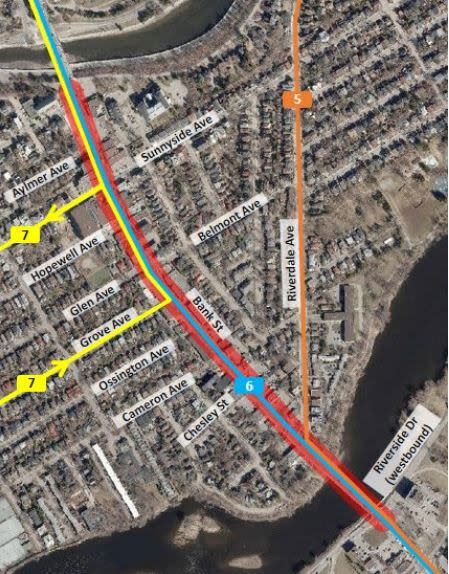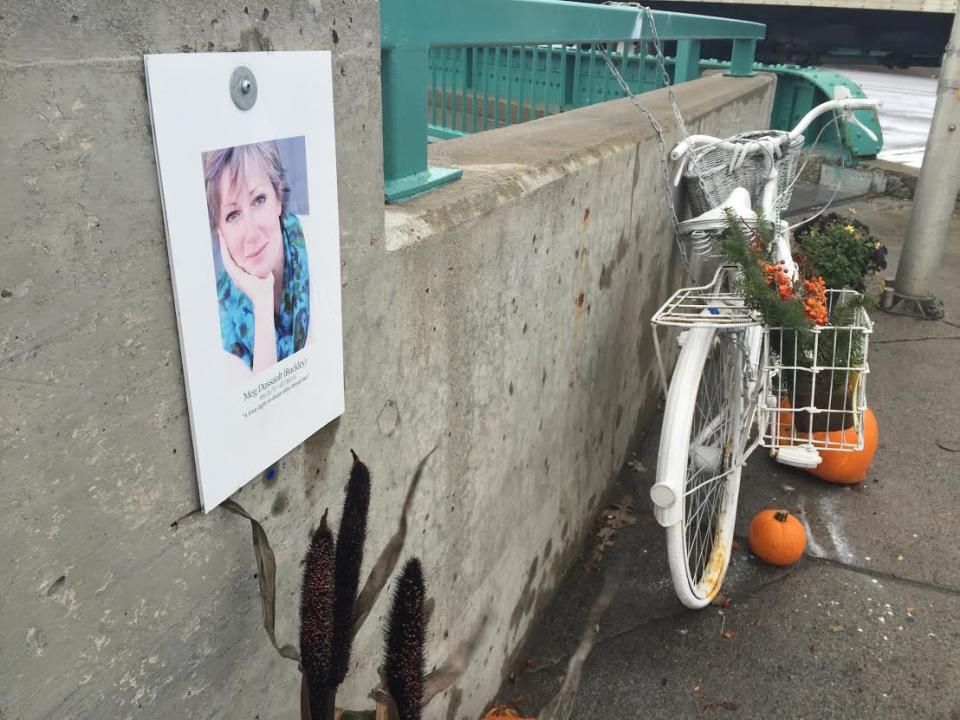Billings Bridge bike lanes get committee's OK

Cyclists could soon see improvements to bike infrastructure in Old Ottawa South and Billings Bridge after the city's transportation committee approved a list of staff recommendations Thursday morning.
The area has been identified as a high-risk zone for collisions involving cyclists, including a fatal collision 10 years ago.
To rectify that, city staff recommend adding bike lanes to the bridge connecting the two neighbourhoods, as well as modifications to the intersections at either end — Bank Street and Riverdale Avenue, and Bank and Riverside Drive westbound.
The report doesn't specify whether the bike lanes over the bridge would be segregated, but three lanes of traffic would be maintained.

A an aerial image showing the stretch of Bank Street staff studied for the report, with Billings Bridge at the lower right. (City of Ottawa)
Staff also recommend reserving a northbound lane on Bank Street for buses during peak afternoon hours. Cyclists would also be allowed to use the lane.
"It's long been seen as a challenge, as a safety issue and as an important missing link to address," said Deborah Lightman, the city's program manager of active transportation planning.
"So we're happy to have a solution to improve the conditions."
The report requires the approval of city council next month.
According to statistics contained in the staff proposal, 70 collisions were reported at the intersection of Bank Street and Riverside Drive between 2017 and 2021. Five involved cyclists and three involved pedestrians.
"Four out of the five cyclist-involved collisions involved a 'right hook' between a driver southbound on Bank Street turning right onto Riverside Drive and a cyclist travelling southbound through the intersection," according to the report.
On of those occurred in 2013 when cyclist Meg Dussault was hit by a cement truck and killed.
Cyclists applaud proposal
"I can tell you it is uncomfortable, generally," said Bike Ottawa's William van Geest during his public delegation Thursday.
"Your choice is between riding on the road with a steel barrier on your right and impatient drivers behind you and on your left, or riding on the narrow sidewalk and endangering people there."
Delegate Neil Saravanamuttoo also praised the proposal.
"We're getting collisions, according to city data, on average every 26 days at this intersection," he noted.

A diagram showing the location of the bike lanes between Chesley Street and Riverside Drive. (City of Ottawa)
City staff are hoping to coordinate the work to coincide with the Bank Street Renewal project, which will add cycling lanes between Ledbury Avenue and Riverside Drive.
According to staff, combining the projects would result in a "a significantly lower cost." The latest proposal would cost about $1.5 million and would be funded through the existing budget.
Business owners concerned over loss of parking
To compensate for the changes, a total of 14 on-street parking spots south of Cameron Avenue would be eliminated, while another 41 spots along the east side of Bank Street would be off-limits during afternoon peak hours.
Staff say the project is expected to cause some additional congestion for motorists, adding a few minutes to their morning commute and about one minute to their drive home.
At Thursday's meeting, some area business owners expressed frustration over the loss of those parking spots, warning it will push motorists onto nearby residential streets.
"The majority of us depend on street parking," said Kerry Hodgins, who said she attended the meeting to represent local businesses.
"The people that do have parking lots, that's part of their concern as well, because that just means that non-customers will be parking in their parking lot."

A photo of Meg Dussault and a 'ghost bike' mark the site of the Ottawa cyclist's death in July 2013. The makeshift memorial has since been removed. (Ashley Burke/CBC)
Coun. Wilson Lo, a former bus driver, said he regularly drives that route.
"I have a lot of familiarity with with this stretch of Bank Street and how precarious it really is for cyclists as well as vehicles," the Barrhaven East councillor said.
But he expressed doubt the northbound bus lane would be as effective as the proposal claimed.
"Your bus stops northbound at Riverdale, Cameron, Belmont are before the traffic light … so you're held up anyway," said Lo, who dissented on that aspect of the report.
Coun. Ariel Troster voiced concerns that painted lines don't offer protection from bad drivers, but staff said they have to work within the physical confines of the existing bridge.
The motion was carried with dissent from Coun. Steve Desroches. If approved by council, staff hope work could begin in 2024.


